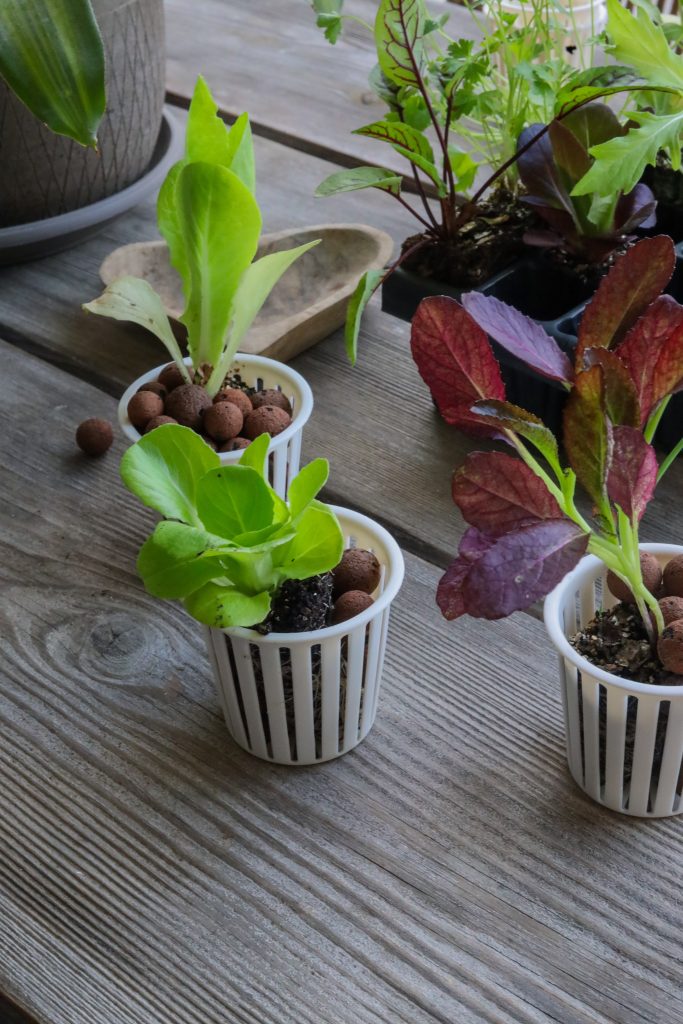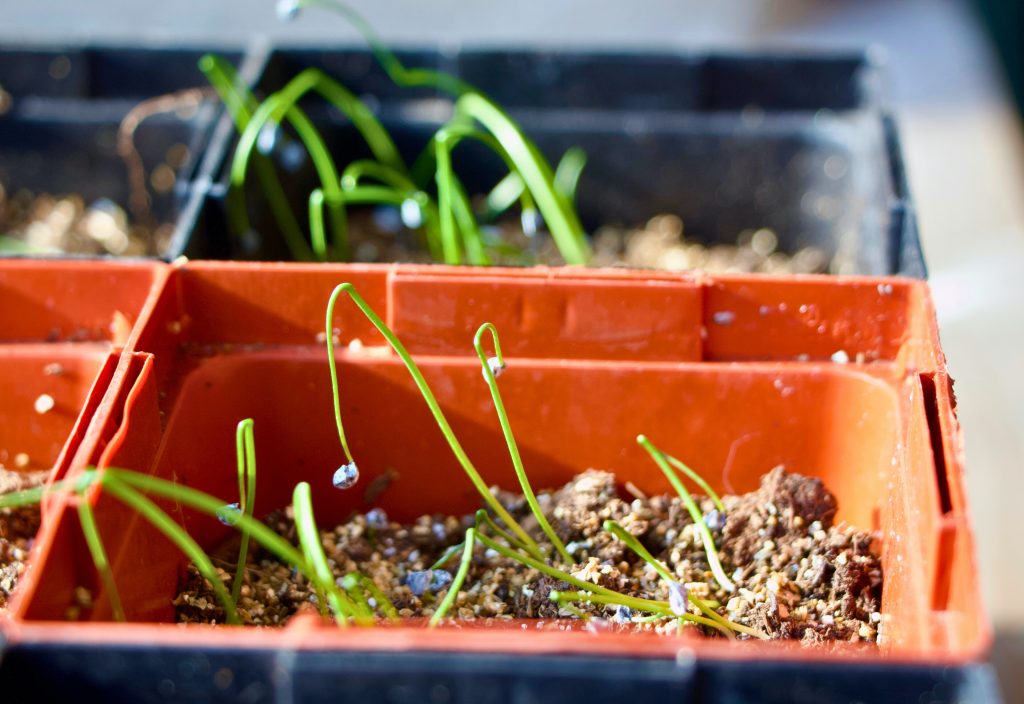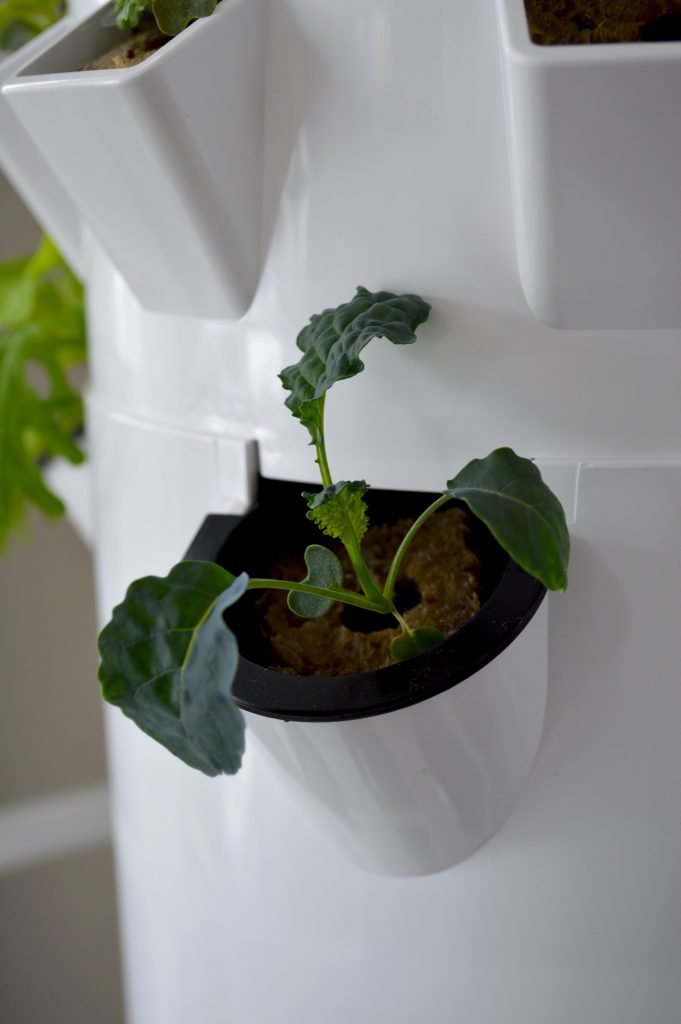After the rush of harvest season, a break from the garden is often welcome. Eventually, missing the garden and all its bounty sets in. Enter hydroponics, and indoor garden system for your home.

Gardens are glorious. There is nothing more exciting than pulling in the a harvest as a sign of all your hard work. Then fall approaches and the harvest slows down. Hopefully you have a larder, pantry or freezer full of all your bounty. But then there are parts of the garden we miss. Fresh herbs for your eggs, crisp lettuce for your sandwich, some greens to chop up and add the finishing touch to your soup. Enter hydroponics.
We are going to take an over view to what is hydroponic gardening, the different types of hydroponic garden systems and why you might want to use hydroponics in your home.
Don’t worry, I won’t leave you hanging. I have post planned for the whole month about hydroponic gardens. I’m going to walk you through how I set up my indoor hydroponic garden. Then how I start seeds and get the plants into my system. If you have ever considered hydroponic gardening, stayed tuned!
What is hydroponic gardening?
At its essence, hydroponic gardening is gardening with water. Hydroponics comes from 2 greek works. Hydro = water, ponos = work. Hydroponics is where the water does the work. Hydroponic gardening systems can be small (a single plant) or large (some use entire shipping containers). Most are designed for indoor use, but with the correct temperature and weather conditions, hydroponic gardens can be used outdoors.
Hydroponics allows control over environmental conditions in order to maximize plant growth. Most plant pests and disease require the soil in order to survive and spread. Because plants are grown without soil you reduce the chance of plant pests and diseases.

Hydroponic garden components
Though there are different types of hydroponics systems, they all have a few things in common when it comes to the components needed to set them up.
1. Growing Media
The growing media is what supports the plants weight and anchors the root system in place. While it replaces the soil used in a traditional garden, in a hydroponics system it provides no nutrients to the plant.
2. Net Pots
Net pots are mesh/plastic pots that hold the plant. You put the growing medium inside of the pot. The mesh allows the roots to grow out and reach the nutrient solution. It also provides drainage so that the roots are not sitting in the solution all the time.
3. Circulating Pump
Almost all hydroponic systems will require a pump of some sort. The pump can be used to circulate the nutrient solution, so the plants can access it and grow. Or in some set ups the pump is used to circulate oxygen to the plants, because the roots in resting permanently in the nutrient solution.
4. Nutrient Reservoir
This is where the water is kept. Liquid nutrient solution is added to the water so that the plants have everything they need to grow.

Types of hydroponic gardening systems
1. Wicking System
A wicking system is a completely passive form of hydroponic gardening. It is simple and uses no pumps or electricity. Plants are grown in an absorbent medium with a nylon “wick” going from the plant to the nutrient solution reservoir. This type of system is good for small plants or plants that don’t require a lot of water.
2. Deep Water Culture
In this hydroponic system the plant roots grow directly into the nutrient solution. Air is pumped into the solution via an air pump with air stones. The air stones ensure the plants have sufficient oxygen and don’t drown.
Because the plants are grown directly in the nutrient solution you can expect big growth from this system. It is perfect for heavy feeding plants or fruit producing plants (think tomatoes).
3. Nutrient Film Technique
For this hydroponic system, the nutrient solution is pumped into sloped channels that hold the plants. The solution then flows through the channels, over the root system and back into the nutrient resevoir.
This system works best for small plants like leafy greens.
4. Ebb & Flow or Flood & Drain
Plants are in large grow beds that are filled with growing medium. A timer is used to flood the bed with nutrient solution at scheduled intervals. A drain on one end ensures that the bed doesn’t over flow. This type of system works well for all kinds of plants
5. Drip Hydroponics
This system is easy to use. Easy to set up. Easy to make changes to. The nutrient solution is pumped directly to the base of the plants via tubes. The tubes have drip nozels on the end to control the flow of the nutrient solution.
6. Aeroponics
For this system, plants are suspended in the air and the nutrient solution is sprayed on the roots. The difficultly with this hydroponic system lies in making sure the misters can spray the entire root system.

Why have a hydroponic garden?
For us, we have a hydroponic garden in order to extend our growing season. Gardening season here is short, like REALLY short. We ultimately decided to get a hydroponic garden so we could have that garden fresh taste in the depth of winter.
I love to fill our hydroponic garden with herbs. We love to have basil, parsley, dill, sage, chervil and more just waiting to be used in our latest recipe. A little fresh lettuce adds a nice touch to a sandwich. And you can beat the freshness of going and picking it directly from the garden right before you want to use it.
But why else might you want to add a hydroponic garden to your home? Enhanced yields. Because you are able to control the various elements that effect plant growth, think the pH of the water, the nutrient contents of the water, the amount of light; you are able to effect the yield of the plants. More control = higher yields.
Hydroponic gardens use less water. WHAT! Yes! Hydroponic gardens can use up to 10x less water than a traditional garden. This is because the water in the system is captured and reused for subsequent waterings.
Hydroponic gardens can take up less space than traditional gardens. When you are designing your own system, you can tailor it to suit your needs. Tight on space? Think vertical!

I hope I have inspired you to at least consider a hydroponic garden. There is no need to go all out and try to replace the grocery store. But if you can grow even a few of the items that you pay a premium for during the winter months (I’m looking at you fresh herbs in tiny plastic boxes!!) I would argue that hydroponics might be worth it.
What would you grow in a hydroponic garden? Leave a comment and let me know!

[…] adventure this month, I am getting ready to set up our indoor hydroponic garden for the winter. Last week I went over what a hydroponic garden is and why you might want one for your […]